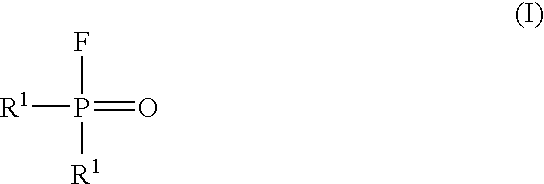Non-Aqueous Electrolyte for Battery and Non-Aqueous Electrolyte Secondary Battery Comprising the Same
a non-aqueous electrolyte and battery technology, which is applied in the direction of electrolytes, cell components, basic electric elements, etc., can solve the problems of lowering the battery performance, short-circuiting of the battery, and uneven electrodeposition and dissolution of lithium metals, and achieve excellent load characteristics, high flame retardance, and excellent electric conductivity and electrochemical stability
- Summary
- Abstract
- Description
- Claims
- Application Information
AI Technical Summary
Benefits of technology
Problems solved by technology
Method used
Image
Examples
example 1
[0047]A non-aqueous electrolyte is prepared by dissolving LiPF6 at a concentration of 1 mol / L in a mixed solvent comprising 10% by volume of fluorophenyl difluorophosphate, 45% by volume of ethylene carbonate and 45% by volume of methyl ethyl carbonate, and the flame retardance of the non-aqueous electrolyte is evaluated by the following method (1). A result is shown in Table 1.
[0048](1) Evaluation of Flame Retardance
[0049]A burning length and a burning time of a flame ignited under an atmospheric environment are measured and evaluated according to a method arranging UL94HB method of UL (Underwriting Laboratory) standard. Concretely, a test piece is prepared by impregnating a SiO2 sheet of 127 mm×12.7 mm with 1.0 mL of the electrolyte based on UL test standard and evaluated. Evaluation standards of non-combustibility, flame retardance, self-extinguishing property and combustion property are shown below.
In a case that a test flame does not ignite a test piece (combustion length: 0 m...
example 2
[0053]A non-aqueous electrolyte is prepared in the same manner as in Example 1 except that 50% by volume of bis(trifluoroethyl) fluorophosphate, 25% by volume of ethylene carbonate and 25% by volume of methyl ethyl carbonate are used in “the preparation of the non-aqueous electrolyte” in Example 1, and the flame retardance of the resulting non-aqueous electrolyte is evaluated. Also, a non-aqueous electrolyte secondary battery is made in the same manner as in Example 1, and the initial discharge capacity and the cyclability of the battery in the discharge-recharge test are measured and evaluated, respectively. Results are shown in Table 1.
example 3
[0054]A non-aqueous electrolyte is prepared in the same manner as in Example 1 except that 100% by volume of tetrafluoropropyl difluorophosphate is used in “the preparation of the non-aqueous electrolyte” in Example 1, and the flame retardance of the resulting non-aqueous electrolyte is evaluated. Also, a non-aqueous electrolyte secondary battery is made in the same manner as in Example 1 except that the negative electrode is a lithium sheet, and the initial discharge capacity and the cyclability of the battery in the discharge-recharge test are measured and evaluated, respectively. Results are shown in Table 1.
PUM
 Login to View More
Login to View More Abstract
Description
Claims
Application Information
 Login to View More
Login to View More - R&D
- Intellectual Property
- Life Sciences
- Materials
- Tech Scout
- Unparalleled Data Quality
- Higher Quality Content
- 60% Fewer Hallucinations
Browse by: Latest US Patents, China's latest patents, Technical Efficacy Thesaurus, Application Domain, Technology Topic, Popular Technical Reports.
© 2025 PatSnap. All rights reserved.Legal|Privacy policy|Modern Slavery Act Transparency Statement|Sitemap|About US| Contact US: help@patsnap.com



